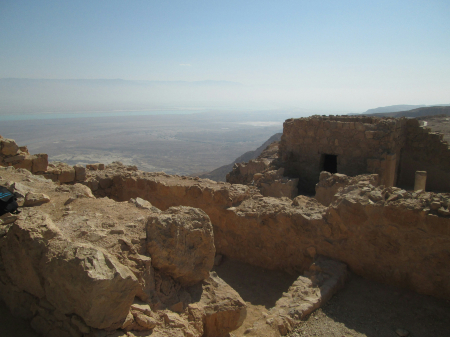We ask you, urgently: don't scroll past this
Dear readers, Catholic Online was de-platformed by Shopify for our pro-life beliefs. They shut down our Catholic Online, Catholic Online School, Prayer Candles, and Catholic Online Learning Resources essential faith tools serving over 1.4 million students and millions of families worldwide. Our founders, now in their 70's, just gave their entire life savings to protect this mission. But fewer than 2% of readers donate. If everyone gave just $5, the cost of a coffee, we could rebuild stronger and keep Catholic education free for all. Stand with us in faith. Thank you.Help Now >
New Evidence Supports Biblical Account of Moses Leading Israelites to the Promised Land
FREE Catholic Classes
Archaeologists have made a groundbreaking discovery in the ancient city of Zanoah, providing significant evidence that supports the Biblical narrative of Moses leading the Israelites to the Promised Land. This find by the Israeli Antiquities Authority includes stone walls, pottery, and other artifacts dating back over 3,200 years, shedding light on the historical context of the Exodus story.

Photo credit: Lukas Kacaliak
Highlights
7/15/2024 (1 year ago)
Published in Middle East
Keywords: Biblical archaeology, Moses, Promised Land, Zanoah, Israelite artifacts, King Hezekiah
Zanoah, mentioned in the Old Testament, is now known to have been a flourishing city during the time when the Israelites are said to have arrived in Canaan, around 1406 to 1407 BC. The recent excavations have revealed ancient agricultural terraces and well-preserved pottery, crucial in understanding the lifestyle and activities of the inhabitants during that period.
One of the most striking discoveries is a broken jar handle bearing the name of a king described in the Bible. This artifact adds a layer of historical authenticity to the Biblical accounts. The jar handle, stamped with the phrase 'of the King,' likely honors King Hezekiah's reign in Judah around 701 BC. King Hezekiah is a significant Biblical figure known for his religious reforms and efforts to centralize worship in Jerusalem, as described in the books of Kings and Chronicles.
The excavations in Zanoah uncovered walls constructed from large white rocks, believed to be retaining walls for farming terraces. These terraces were used to create level planting areas and to protect the steeper soil from erosion, indicating advanced agricultural practices. The team also found well-preserved pottery, with one piece featuring an LMLK stampâ₏"ancient Hebrew seals meaning 'of the King.' This discovery is particularly rare in the Judah foothills, suggesting Zanoah's importance in the region.
The Biblical story of Moses begins with the Israelites enslaved in Egypt. The Pharaoh, coerced by ten terrible plagues, eventually agrees to release them. Moses then leads the Israelites across the miraculously-parted Red Sea. Upon reaching the Sinai Peninsula, they travel to Mount Sinai, where Moses receives the Ten Commandments. The group then heads to the southern border of Canaan, but, being too scared to enter, they are condemned to spend decades in the wilderness by God. After passing years at the oasis of Kadesh Barnea, they travel to the eastern border of Canaan, where Moses dies and is buried on Mount Nebo.
In the subsequent Book of Joshua, Joshua takes over the leadership of the Israelites, leading them into the Promised Land across the River Jordan and conquering Jericho. Zanoah is mentioned in the Book of Joshua, specifically in Joshua 15:34,56, which outlines the boundaries and cities within the tribal allotment of Judah.
The archaeological findings in Zanoah include bowls and jugs, one of which had perforations suggesting it may have been used as a lantern. The team also uncovered metal objects, including bronze jewelry such as a ring and earring fragment. Other remnants indicating ancient human habitation included iron tools, nails of various sizes, and bronze strips used for welding iron.
The pottery fragments littered across the landscape date to the time the Israelites are believed to have arrived after their 40 years of wandering in the wilderness. A decorated fragment of a cosmetic bowl made of white limestone featured a wide rim adorned with three concentric bands separated by gaps. The external and internal bands are narrow and feature a rope decoration, while the central band is wide with an intermittent grid pattern.
While it is likely that some of the finds originated in the ruin and were subsequently washed down the slope over the years, the majority, especially those from the early Byzantine period, relate to farming activities conducted on the hill slopes. The large number of artifacts indicates the site's importance and potential significance in understanding the region's historical and Biblical context.
These discoveries not only provide a deeper understanding of the ancient city's role and significance but also offer tangible evidence that aligns with Biblical accounts. The ongoing research and excavation at Zanoah promise to uncover more secrets of the past, further bridging the gap between archaeology and the Bible.
Join the Movement
When you sign up below, you don't just join an email list - you're joining an entire movement for Free world class Catholic education.
-

- Easter / Lent
- Ascension Day
- 7 Morning Prayers
- Mysteries of the Rosary
- Litany of the Bl. Virgin Mary
- Popular Saints
- Popular Prayers
- Female Saints
- Saint Feast Days by Month
- Stations of the Cross
- St. Francis of Assisi
- St. Michael the Archangel
- The Apostles' Creed
- Unfailing Prayer to St. Anthony
- Pray the Rosary
A Generation Without Christ Breeds Violence — The Answer Is Catholic Education
Rediscovering the Face of God in Others: Pope Leo’s Call to Fraternity
‘Blessed are the Peacemakers’: A Catholic Response to America’s Mass-Shooting Crisis
Daily Catholic
 Daily Readings for Saturday, September 13, 2025
Daily Readings for Saturday, September 13, 2025 St. John Chrysostom: Saint of the Day for Saturday, September 13, 2025
St. John Chrysostom: Saint of the Day for Saturday, September 13, 2025 A Prayer for the Gift of Wisdom: Prayer of the Day for Saturday, September 13, 2025
A Prayer for the Gift of Wisdom: Prayer of the Day for Saturday, September 13, 2025 Daily Readings for Friday, September 12, 2025
Daily Readings for Friday, September 12, 2025 St. Ailbhe: Saint of the Day for Friday, September 12, 2025
St. Ailbhe: Saint of the Day for Friday, September 12, 2025- Family Prayer Time: Prayer of the Day for Friday, September 12, 2025
![]()
Copyright 2025 Catholic Online. All materials contained on this site, whether written, audible or visual are the exclusive property of Catholic Online and are protected under U.S. and International copyright laws, © Copyright 2025 Catholic Online. Any unauthorized use, without prior written consent of Catholic Online is strictly forbidden and prohibited.
Catholic Online is a Project of Your Catholic Voice Foundation, a Not-for-Profit Corporation. Your Catholic Voice Foundation has been granted a recognition of tax exemption under Section 501(c)(3) of the Internal Revenue Code. Federal Tax Identification Number: 81-0596847. Your gift is tax-deductible as allowed by law.


 Daily Readings for Saturday, September 13, 2025
Daily Readings for Saturday, September 13, 2025 St. John Chrysostom: Saint of the Day for Saturday, September 13, 2025
St. John Chrysostom: Saint of the Day for Saturday, September 13, 2025 A Prayer for the Gift of Wisdom: Prayer of the Day for Saturday, September 13, 2025
A Prayer for the Gift of Wisdom: Prayer of the Day for Saturday, September 13, 2025 St. Ailbhe: Saint of the Day for Friday, September 12, 2025
St. Ailbhe: Saint of the Day for Friday, September 12, 2025


